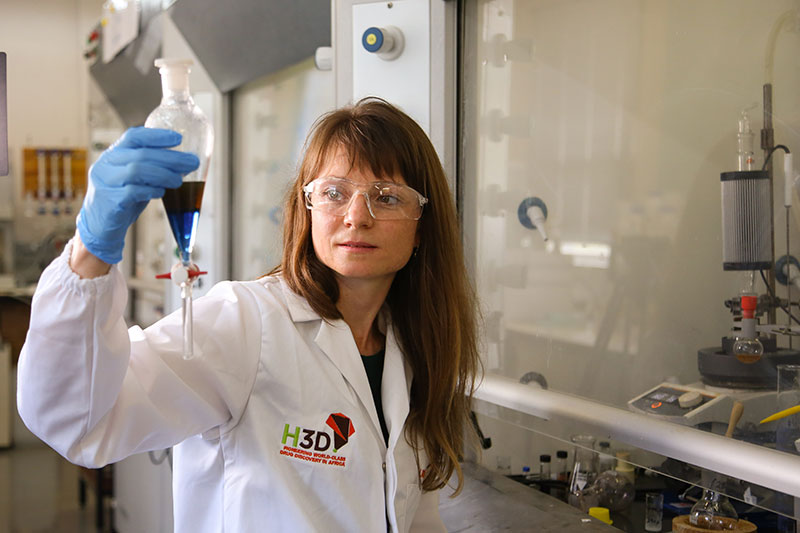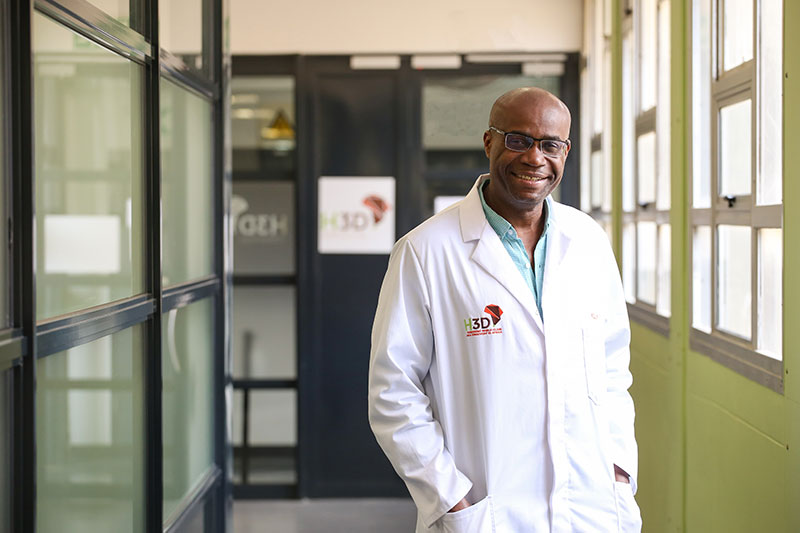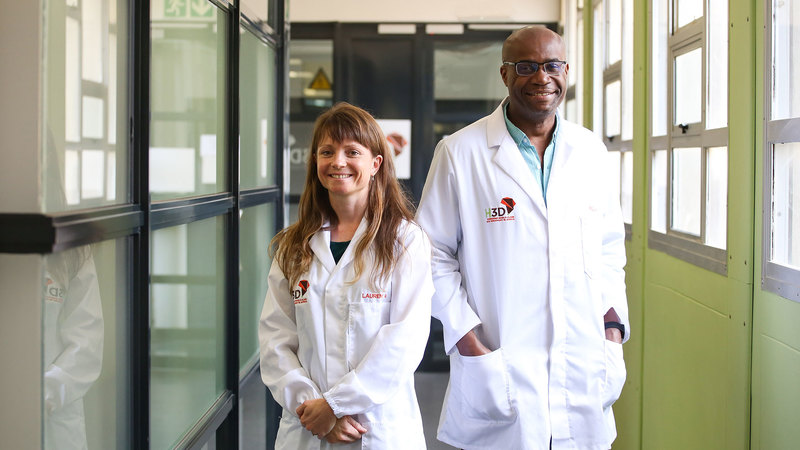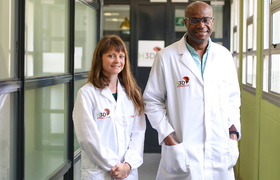New research: Cancer drug with potential to be used against malaria
20 October 2022 | Story Helen Swingler. Photos Je’nine May. Video and edit Ruairi Abrahams. Director Roxanne Harris. Read time 9 min.A cancer drug currently in clinical trials has shown the potential to protect from, cure and prevent transmission of malaria. The breakthrough finding by the University of Cape Town (UCT) researchers, in collaboration with several local and international institutions from the United States, Germany and Spain, offers new hope against a disease that kills over half a million people annually, most severely affecting children under five, pregnant women and patients with HIV.
The findings were released on 19 October in a new paper, “The anticancer human mTOR inhibitor sapanisertib potently inhibits multiple Plasmodium kinases and lifecycle stages”, published in the journal Science Translational Medicine.
The first author is Dr Lauren Arendse of the UCT Drug Discovery and Development Centre (H3D), an integrated and interdisciplinary drug discovery research organisation. The senior lead author is Professor Kelly Chibale, the founder and director of H3D, Neville Isdell Chair in African-centric Drug Discovery and Development and a full member of the university’s Institute of Infectious Disease and Molecular Medicine.

The recent increase in malaria cases and deaths worldwide, partially attributed to disruptions during the COVID-19 pandemic, coupled with increasing reports of resistance to first-line artemisinin-based combination therapies, highlights the urgent need for new ways to address this devastating disease, said the UCT researchers.
The rapid discovery and development of new treatments able to combat existing drug resistance, and with low risk of selecting for new resistance, is crucial for malaria control.
Main findings
The paper describes the findings of a rational approach towards discovering a new use in malaria treatment for the investigational cancer drug sapanisertib. This is in clinical trials for the treatment of various cancers such as breast cancer, endometrial cancer, glioblastoma, renal cell carcinoma, and thyroid cancer.
The findings show that sapanisertib has the potential to protect from, cure and block malaria transmission by killing the human malaria parasite when it is in the liver (where clinical symptoms are not observed), in the human host red blood cells (where clinical symptoms are observed) and when it divides sexually within the host red blood cells to produce the transmissible forms of the parasite. These parasites are taken up by the female Anopheles mosquito during a blood meal and are passed on during subsequent blood meals to infect another person. (Female mosquitoes need the ingredients found in blood to lay their eggs.)

The researchers also established the mechanism of action: how sapanisertib kills the human malaria parasite. The drug exhibits polypharmacology, inhibiting multiple proteins called kinases in the malaria parasite.
Sapanisertib’s multistage activity and its antimalarial efficacy, coupled with potent inhibition of multiple protein targets – including at least two that have already been shown to be vulnerable targets for chemotherapeutic intervention – will underpin further research.
This work will evaluate the potential of repurposing sapanisertib to treat malaria, said Dr Arendse.
The drug repurposing approach
The approach used to identify sapanisertib is known as drug repurposing. This is about finding new uses for an existing drug, approved by a regulatory agency in one disease area, in another disease.
“Discovering and developing a new medicine is a lengthy and expensive process.”
“Discovering and developing a new medicine is a lengthy and expensive process, often with low returns in terms of the number of drugs that finally make it to the market,” said Professor Chibale.
“The problem is amplified in neglected and tropical diseases such as malaria where existing resources are strained and the financial returns low.”
Chibale added, “The drug repurposing approach of investigating existing drugs as potential therapies for other diseases shortens the process as in most cases the candidates, in this case sapanisertib, will have been through several stages of clinical development and will have well-known exposure and safety profiles in humans.”
Exploiting genome information
While new uses for approved drugs have sometimes been found serendipitously in the drug repurposing approach, strategies exist to rationally identify drugs that can be used for other diseases.
“In this work we have exploited known drugs that act through protein targets of human origin to identify drugs against malaria parasites with homologous protein targets – that is protein targets that have similar structures and commonly share related functions,” said Arendse.
This strategy can be referred to as target repurposing. In cancer, sapanisertib inhibits a protein kinase called the mammalian target of rapamycin (mTOR). mTOR acts as a key regulator for a wide range of cellular processes, including immune responses and autophagy (consumption of the body’s own tissue as a metabolic process occurring in starvation and certain diseases).
Kinases have been extensively investigated as therapeutic targets in many diseases because of their importance in cellular function. This makes them attractive for repurposing in other diseases, including malaria. Kinase targets essential to multiple stages of the malaria parasite life cycle have in fact already been identified.
Potential impact of the research
To control and ultimately eliminate malaria, there is a critical need for a pipeline of novel medicines with novel mechanisms of action, said Arendse. This is vital to overcome resistance to currently used antimalarial drugs and the eventual inevitable emergence of drug resistance to new antimalarials. Treatments with activity against multiple stages of the parasite life cycle, particularly against blood, transmission and/or liver stages are also highly desirable.
To combat infection and contribute to malaria eradication, the drug pipeline should also include agents that are chemoprotective against various malaria parasite (Plasmodium) strains.
As such, the published study opens new avenues for the rational development of malaria drugs designed to inhibit two or more protein targets in the malaria parasite. This will potentially have big advantages for patients in a clinical setting as it is more challenging for the parasite to develop resistance to a drug that kills through multiple mechanisms.
Designed polypharmacology may also benefit patients by minimising the pill and financial burden arising from costs associated with combination drug regimens. The current drug regimens typically require the combination of two or more drugs that inhibit different single parasite protein targets/pathways.
It is also noteworthy that building appropriate combination drug regimens needs more laboratory time, resources, and a significant amount of data, said Arendse.
The next steps
Recognising the potential safety concerns of using a cancer drug in treating malaria, the UCT team is working to understand the drivers of sapanisertib efficacy, the corresponding dose requirements, and therapeutic window for malaria. The aim is to compare how sapanisertib’s predicted human dose for malaria differs from the maximum tolerated dose that is used to treat cancer.
“This work highlights the importance of local and international research partnerships to solve critical human challenges.”
Modelling tools will help the team do this.
“This work highlights the importance of local and international research partnerships to solve critical human challenges based on mutual interest and responsibility,” said Chibale. “It demonstrates how advances in science and medicine can be made when industry and academic institutions share knowledge and expertise.”
Arendse’s work in malarial kinases at H3D was boosted by the award of a Future Leaders – African Independent Research (FLAIR) Fellowship in 2020. The fellowship supports early-career scientists.
“It is a privilege to play a small part in a global shared vision to develop new drugs for malaria,” Arendse said. “This study has enabled me to rapidly expand my networks and knowledge within the malaria field and has served as a catalyst for new ideas and collaborative research projects. As an early-career scientist working in drug discovery – which is multidisciplinary by nature – these partnerships are invaluable.”
Arendse is also excited to see drug discovery capacity growing in Africa.
“Through the FLAIR Fellowship and studies such as this one, I have been able to expand the enzymology capabilities for target-based drug discovery at H3D. Training students and building a team of young scientists capable of world-class research is extremely rewarding.”
 This work is licensed under a Creative Commons Attribution-NoDerivatives 4.0 International License.
This work is licensed under a Creative Commons Attribution-NoDerivatives 4.0 International License.
Please view the republishing articles page for more information.











